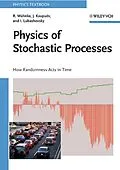Dieses Buch, auf der Grundlage langjähriger Vorlesungserfahrung der Autoren verfasst, kombiniert in einzigartiger Weise theoretische Grundlagen der Stochastik aus der Mathematik und Physik mit einer Vielzahl von Rechenbeispielen unterschiedlicher Schwierigkeitsgrade. Die Lösungen zu den zahlreichen Übungsaufgaben können von Dozenten angefordert werden.
Autorentext
Reinhard Mahnke received his Ph.D. from the University of Rostock, Germany, where he became assistant professor in Theoretical Physics in 1990. As author of numerous research papers, lecture notes and textbooks he was organizer of several summer schools on many-particle physics in Russia. Professor Mahnke's fields of expertise are nonlinear dynamical models, phase transitions and traffic flow including self-organizing systems.
Jevgenijs Kaupu's graduated from the Department of Physics and Mathematics at the University of Latvia in Riga. In 1995, he received his Ph.D. degree for a thesis entitled "Role of fluctuations in the phase transition region". Since 1997, he has been working at the Institute of Mathematics and Computer Science of the University of Latvia, where he was a senior researcher from 2003 to 2005. Today he holds a post as associated professor at the Liepaja Pedagogical Academy, Latvia. The main topics of his work are phase transitions and critical phenomena, traffic flow theory and ferroelectrics. Professor Kaupu's is the author of more than 70 scientific publications.
Ihor Lubashevsky received his Ph.D. from the Moscow Institute for Physics and Technology in 1980. In 1993, he became assistant professor at Moscow State University. Four years later, he accepted a post as leading staff scientist at the theory department of the A. M. Prokhorov General Physics Institute, Russian Academy of Sciences. He also is chair and professor at the Department for the Modelling of Radio- Physical Processes, Moscow Technical University of Radio- Engineering, Electronics and Automation. Professor Lubashevsky's research experience spans over statistical physics, in particular non-equilibrium many particle systems.
Klappentext
Based on lectures given by one of the authors, who looks back on many years of experience in teaching stochastic processes, this textbook is unique in combining basic mathematical and physical theory with numerous simple and sophisticated examples as well as detailed calculations.
In addition, applications from different fields are included so as to strengthen the background learned in the first part of the book. With its exercises at the end of each chapter (and solutions available to lecturers), students and researchers at different educational levels will benefit from this book.
Solutions manual available for lecturers on www.wiley-vch.de
Zusammenfassung
Based on lectures given by one of the authors with many years of experience in teaching stochastic processes, this textbook is unique in combining basic mathematical and physical theory with numerous simple and sophisticated examples as well as detailed calculations.
In addition, applications from different fields are included so as to strengthen the background learned in the first part of the book. With its exercises at the end of each chapter (and solutions only available to lecturers) this book will benefit students and researchers at different educational levels.
Solutions manual available for lecturers on www.wiley-vch.de
Inhalt
Fundamental Concepts
Multidimensional Approach
The Master Equation
The Fokker-Planck Equation
The Langevin Equation
One-Dimensional Diffusion
Bounded Drift-Diffusion Motion
The Ornstein-Uhlenbeck Process
Nucleation in Supersaturated Vapors
Vehicular Traffic
Noise-Induced Phase Transitions
Many-Particle Systems
Titel
Physics of Stochastic Processes
Untertitel
How Randomness Acts in Time
EAN
9783527626106
ISBN
978-3-527-62610-6
Format
E-Book (pdf)
Hersteller
Herausgeber
Veröffentlichung
04.08.2009
Digitaler Kopierschutz
Adobe-DRM
Dateigrösse
6.76 MB
Anzahl Seiten
447
Jahr
2009
Untertitel
Englisch
Unerwartete Verzögerung
Ups, ein Fehler ist aufgetreten. Bitte versuchen Sie es später noch einmal.
